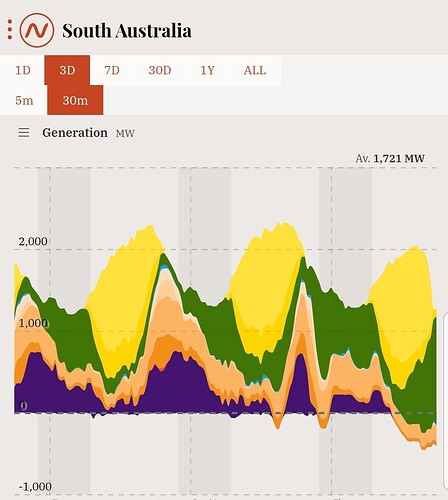to only cut emissions to zero, either might be sufficient, but better to err on the side of overshooting than under. to draw down co2 already emitted we need both.
So COP26 was not enough as expected. Stopping deforestation is nice but nobody knows if it will be done. Indonesia already questions that since they dont think that this alligns with their development plans.
I currently read a magazine about saving the oceans and I think there is still potential although it needs more research but the ability of kelp forests, mangroves esp and seagrass meadows to store carbon is still largely untapped. Not to mention that these areas are also great for a diverse fauna.
I was also surprised that they wrote that the fishing grounds within US waters are still intact due through good management. The EU is a completely different picture. Lots of our fishing grounds are pretty much broken.
Interestingly, when asked to evaluate their personal commitment to protecting the environment, roughly two thirds of those surveyed gave themselves a far higher rating than their fellow citizens.
According to Kantar, there is a “clear feeling at an individual level, that other people are less committed than we are ourselves”.
Respondents were highly in favour of solving the issue of climate change via increased government regulation of corporations. They overwhelmingly believed those in office should “assume a large share of responsibility for protecting the environment, while considering themselves to be relatively good at ‘doing their bit’ in this area”.
Kantar’s survey revealed that in almost all countries polled, at least three out of four people (except in Germany at 62 per cent) were proud of their contribution to climate change.
“This calls into question whether people really are willing to do more,” Kantar surmised.
A large majority (76 per cent) said they would be happy with stricter environmental rules and regulations, but 46 per cent also said they didn’t need to change their personal habits.
Pure delusion.
Yes, and it’s unavoidable. Humans are wired this way generally. It’s very reminiscent of a number of studies showing that the majority of people rate themselves as above average intelligence, above average at driving, etc.
It’s also, in this case, a predictable outcome of “consumerising” environmentalism. People think they are improving the environment if they buy a lot of stuff that comes in green boxes with pictures of plants on them. This is convenient for them and for the people selling consumer goods.
TLDR: Divorce derails development plans and bad capitalist takes over and starts installing gas lines into a neighborhood that is powered by solar.
not sure where to post it, but the latest in russian misinformation informs me that biden apparently contributed to emissions at COP by farting while standing next to some royals, causing lady camilla to scatter or something.
not sure when this will hit english language outlets, but at least now you won’t be surprised when you see fox/newsmax clips.
yay coal

https://twitter.com/drvolts/status/1465062849785446402
https://twitter.com/drvolts/status/1465063518156124160
The figure over the last 12 months has been 62% renewables, but new technology coming online - the above-mentioned syncons as well as a new renewables power station in the mid-north - will improve that figure over the coming year. The State Government (conservative!) is targeting 100% net renewables for the grid by 2030, but is likely to achieve it well before then.
giant synchronous “spinning machines”
In some parts of the world we call those flywheels, or in Aussie: filwizzees.
They’re not flywheels, more sophisticated than that.
Fancy flywheel
in my understanding it’s a similar distinction to the difference between a capacitor and a battery. very short action to reduce spikes vs more prolonged storage to smooth out valleys. is that it?
The fancy fly wheel also serves a very different purpose to gas.
It does? Looks pretty similar to me.
The fancy fly wheels add inertia and inductive or capacitive load to support the grid. Typically to adjust for very short time fluctuations. Voltage control and frequency control.
A gas turbine provides inertia as well, but is mainly about providing large amounts of flexible power. I.e. that can ramp up and down at short notice as solar and wind ramp up and down (especially in evenings).
We need something to fill in the gaps for solar and wind. Storage is key, but has yet to be deployed anywhere close to the right scale at the right price.
If you are interested in the aus grid. Have a look at open nem.
The above shows electricity generation in the SA grid. Wind in green. Solar in yellow. You can see the massive fluctuations up and down. That has to be filled with imports from the rest of Australia (purple) and gas (light browns)
South Australia is fairly unique in that it just piggy back off the rest of aus. The success of high renewable penetration there cant be extrapolated to a larger grid that doesnt have the luxury of importing or exporting at a large scale
You can’t roll coal on cyclists with that!
Right, but I mean… I don’t know the fine details, but he was making it sound like the inductive/capacitive adjustments were fairly important, in terms of reducing the level of gas support that was needed. Obviously it’s never going to be a 1-for-1 replacement for gas power.
Edit: Like
requiring less natural gas to be running for grid stability.
For grid stability specifically, but maybe that’s not very much to begin with or maybe the reductions aren’t very much. I have no clue of the numbers, just relying on this guy’s take, I’ve read his stuff before and he’s generally reasonable.
Like as I understand it, which isn’t very well, when you have a grid supplied in large part by very unpredictable consumer solar power, for example, you need to have a finely controllable power source like gas so you can ride out the bumps. But if you can make the bumps less, you don’t need as much spare power on hand. A good analogy would be lower-variance gambling meaning you don’t have to have as big a bankroll. Low variance gambling doesn’t make you more money, but it reduces the amount of money you have to have on hand. Low variance power production doesn’t make more power (like gas does) but it reduces the amount of spare power you have to have on hand.


